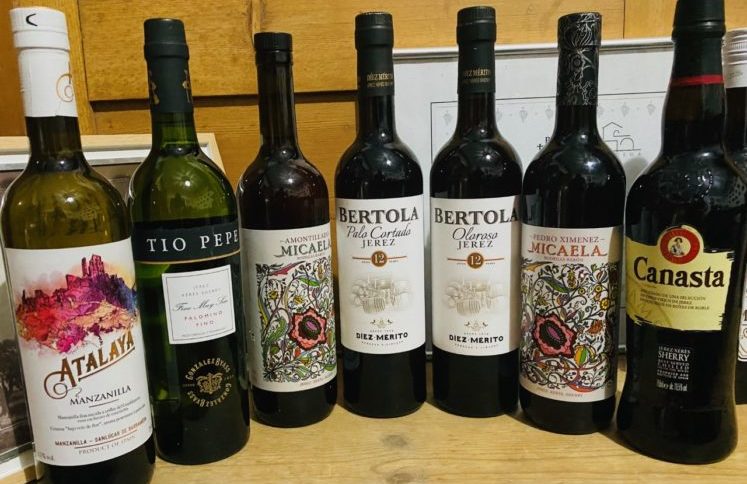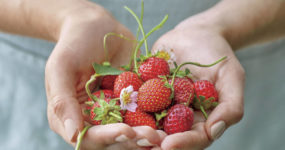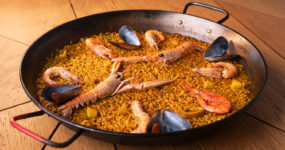##VÍ Vid recently organised a special tasting with the theme of ‘An Introduction to the wines of DO Jerez and Sanlucar de Barrameda’ for our Pedralba Wine Club, who hadn’t met for a year. The tasting was organised for just 16 people to look at the three grape varieties and seven of the eight styles of sherry they produce, each matched with an appropriate tapa.
The styles are Manzanilla, (from the area around Sanlucar) , Fino, Amontillado, Palo Cortado, Oloroso (from a single variety – Palomino), Pedro Ximinez and Moscatel are also monovarietal (sweet) wines and Cream is a blend of Oloroso with Pedro Ximinéz.
The DO covers the triangle from Cadiz to Sanlucar de Barrameda (both on the Atlantic coast and inland to Jerez de la Frontera. The soils are either ‘Albariza’ (blindingly white pure chalk) or alternatively a mix of clay and sand. The vineyards of Sanlucar, Miraflores and Torrebreba produce predominantly Manzanillas; the vineyards of Añina, Balbaina and Los Tercios produce Finos; Macharnudo produces Amontillados; Carrascal produces Olorosos and Chipiona produces sweet wines and Moscatels.
Sherry comes in many different styles in each category; many of the Bodegas were originally English-owned and still have English names. Some bodegas produce their own wines and others sell their wines to ‘Almacenistas’ …who age them for many years before bottling limited releases of the highest quality wines.
The production of each type of sherry is different and we looked at this as we tasted. Sherry is a most versatile wine and the different styles can be drunk throughout a meal, accompanying different dishes. We chose wines from four separate bodegas for this tasting.
1. Manzanilla de Sanlucar de Barrameda: ‘Atalaya’ Bodegas Baron, 15% ABV.
Manzanilla takes its name from Chamomile whose smell it sometimes displays. It is produced around Sanlucar where the Bodegas on the town’s docks on the Guadalquivir River hold the barrels of wine which, it is said, absorb the sea breezes… giving it its salty notes. The wines take the majority of their salty, mineral flavours from the Albariza soils. This is the driest type of Sherry and the most modern. The grapes are picked greener for a higher acidity level. Once the must has been pressed and is on its lees in a concrete tank, it is ‘encabezado’ or dosed with alcohol to between 14.5 -15.5ABV. It is then transferred to American oak barrels or ‘Criaderas y Soleras’. Sherry Butts hold 600 litres but manzanilla is added only to about half this amount, to leave a bigger space for the ‘Vela Flor’.
Vela Flor is the yeast which sits on top of the wine feeding on the air in the barrel and in turn as it churns over, adding flavour and protein to the wine beneath. This dies off during the winter but revives like Persephone in Spring. The wine will remain in solera for about five years before being drawn and bottled. Most Manzanilla is sold in this ‘young and fresh’ style but there are aged Manzanillas as well, some of which can have 20%ABV.
This wine is very pale straw in colour, clean and bright with abundant long legs. On the nose the wine has almonds, hay, chamomile, white fruits and salty and mineral notes. In the mouth it has a good fresh and lively acidity, mineral notes, dried nuts and fruits, well integrated alcohol and is pungent and elegant. An aperitif, which we married with ‘salazones’ but this would be appropriate with ’embutidos’, pickled veg, ceviche, or a ‘fritura’.
2. Fino, ‘Tio Pepe’ Gonzalez Byass, 15%ABV.
Fino is the other pale, dry sherry used for aperitifs. Traditionally the grapes were picked and the larger stalk removed, before leaving them out in the sun for 24 hours to concentrate the sugar just a little. Then, the grapes were pressed in open tanks by foot and the pulp pressed in a screw press. The two musts would be blended together. The wine is also ‘encabezado’ to about 15% ABV and added to barrels or a criadera y solera system. The barrels are filled to a higher level but still not to the top, and the fermentation takes place followed by a period (usually five years) of crianza in the solera before being drawn and bottled. Historically, it was served ‘en rama’ directly from the barrel.
This wine is pale gold, clear and bright. Pungent on the nose, it is more elegant than the Manzanilla with bread dough and yeasty notes from the flor and almonds. In the mouth it is fresh, the almond flavour carries through onto the palate and the wine is fresh and dry with a long satisfying finish. We served this with fresh prawns, any shellfish would be appropriate.
3. Amontillado ‘Michaela’ Bodegas Baron, 17.5% ABV.
If you leave a fino in cask for longer than five years it will go through an oxidative crianza where the air is responsible for the development. The length of time is irregular as is the process as the fino. Generally it becomes an Amontillado with a strength between 16-23%ABV. Given a perfect fino needs at least six years crianza, a golden amontillado will be a much older wine.
After the fino stage this has a further four years of ageing in the air. Old gold in colour and the nose releases a sense of a praline chocolate box, liqueur chocolates, toasted caramel, nuts, bitter almonds, natural woods and a recognisable salt mixture. This wine has a powerful entrance and fills the palate with a silky sensation. An iodine and bitter almond taste appears at this stage with a spicy and warm feeling that if held in mouth, allows you the most out of this wine. It leaves a fresh taste during its finish. We matched this with a spicy meatballs with a sauce. It goes well with chicken, mushrooms, truffles, kidneys, grilled tuna, soups and anchovies.
4. Palo Cortado,Bertola (12 years), Bodegas Diez Merito, 19%ABV
Palo Cortado is a very rare sherry and bottles are much sought after by sherry lovers. The wine can develop differently as we have seen with Fino and Amontillado. It starts as a Fino but develops little or no Velo Flor. After it becomes an amontillado it develops a higher alcohol content and becomes a palo cortado in varying degrees. A law unto itself, it is darker generally in colour but more fragrant, it can be between 16-23%ABV.
This Palo Cortado is exceptional and very rare. Amber tending to Mahogany in colour. Profoundly pungent on the nose this is reduced a little by citrus and creamy notes. In the mouth it has the delicacy of an amontillado and the body of a good oloroso. It has a huge number of levels and flavours, is smooth and very complex. We served it with a blue cheese but it is equally good with rich meaty stews such as ‘rabo de toro’.
5. Oloroso Seco, ’Alfonso’ Bodegas Gonzalez Byass,18%ABV.
Oloroso means ‘fragrant’. It is a dry wine with a hint of sweetness from the glycerines in the wine. Olorosos generally are darker than the finos and amontillados they come from and are used for blending with Pedro Ximinez to make a Cream sherry. However it matches well with lighter cheeses, game dishes and patés. We served it with a country style paté.
This wine is golden amber in colour. intense on the nose with notes of several types of wood, nuts and dried fruits. Meaty, harmonious and with a touch of vanilla in the mouth. A slightly lighter sherry which is not too expensive to use in cookery such as ‘kidney’s in sherry’.
6. Pedro Ximinez, Micaela, Bodegas Baron, 15%ABV.
Known as PX mainly grown in Montilla Moriles and Jerez where it makes sweet wines. The grapes are left on the vine to over mature for at least two weeks in the blazing Andalusian sun. The concentrated very sweet must (dulce pasa) is then stopped from fermenting with alcohol at about 17%ABV.
Mahogany or ebony in colour with huge fat legs and dense appearance. On the nose a massive concentration of dried grapes, walnuts, dried figs, dried apricots, honey and fruits in concentrated syrup, with coffee, pure black chocolate bitterness and licorice. In the mouth very silky on entry, unctuous with an acidity which relieves the sweetness a little. A long and meaty finish. It is the perfect accompaniment with Vanilla ice-cream, (which was our pairing) but also with blue cheeses and turron.
7. Canasta Cream Williams and Humbert, 19.5%ABV
Cream sherry is the only blended sherry, usually from Oloroso and PX. It was created for the UK market. The blending is done by nose in the bodega. The wine is then aged in American oak for several years.
Canasta is a blend of Oloroso and PX with six years crianza. This wine is mahogany in colour with aromas of dried fruits, nuts, dried grapes and toasted sugar. Smooth and silky on the nose with a little heat from the alcohol and a persistent finish. It goes well with tarts made from nuts and orange. We matched it with Tarta de Santiago.
Conclusion
This was a very interesting tasting, the attendees quite sceptical to begin with but convinced by the quality of the wines to try them again.
Article by Riki Wigley and Marian Darás
VÍ Vid is a project supporting the development of wine knowledge and gastronomy in the Valencian Community. We run wine clubs, give tastings of Valencian wines in English and support wine-makers and bodegas directly. We are also contributers to Verema´s ADN Wine Guide. We can be found in Instagram (Vivid8402), and through our blog VÍ Vid at https://vvidblog.wordpress.com and https://www.facebook.com/Vivideventos and in Twitter @vividvinos.
Related Post
This site uses Akismet to reduce spam. Learn how your comment data is processed.

























Leave a comment